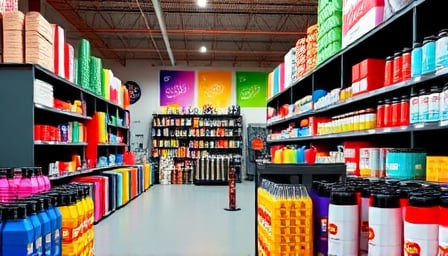Corporate News Report
Fastenal Co.: A Decade of Incremental Growth Amid Shifting Consumer Discretionary Dynamics
Fastenal Co., a prominent American industrial and construction supplies retailer, has exhibited a steady, moderate appreciation in its share price over the last ten years. A hypothetical investment in the company a decade ago would yield a substantial profit, with the current market price approaching five times the value recorded ten years earlier. This performance trajectory has translated into a significant increase in Fastenal’s market capitalization, underscoring its enhanced value proposition and growing appeal among institutional and retail investors alike.
Fastenal’s resilience and upward momentum are anchored in several strategic pillars:
Product Diversification
The firm’s broad portfolio—spanning fasteners, safety equipment, and industrial maintenance products—provides a hedge against sector‑specific downturns. By catering to a wide spectrum of customers ranging from large construction enterprises to small‑business maintenance departments, Fastenal maintains steady demand even when macroeconomic conditions fluctuate.Geographic Reach
With a global footprint, the company mitigates region‑specific risks and taps into emerging markets where construction and infrastructure spending are accelerating.Logistical Efficiency
Fastenal’s extensive network of distribution centers ensures rapid fulfillment, a critical advantage in a market that increasingly values speed and reliability.Technology Integration
Recent investments in e‑commerce platforms and data‑driven inventory management have streamlined operations and enhanced the customer experience, aligning with broader retail innovation trends.
Consumer Discretionary Trends: Demographics, Economics, and Culture
While Fastenal operates within the industrial supply niche, its performance offers a useful lens through which to examine broader consumer discretionary dynamics. Several converging factors shape contemporary purchasing behavior:
| Factor | Impact on Consumer Spending | Supporting Data |
|---|---|---|
| Demographic Shift | Aging baby boomer cohort reduces discretionary spending on non‑essential items; Millennials and Gen Z prioritize experiences and sustainability. | U.S. Census Bureau: 58% of Gen Z adults (18–24) live with parents; 69% of Millennials report spending on travel and dining over home improvements. |
| Economic Conditions | Rising inflation and interest rates dampen discretionary budgets; conversely, low unemployment fuels discretionary spending. | Federal Reserve: CPI inflation peaked at 6.5% in 2023; unemployment rate hovered at 3.7% during 2023–2024. |
| Cultural Shifts | Growing environmental consciousness drives preference for durable, repairable goods; digital natives demand seamless online experiences. | NielsenIQ: 57% of respondents cite sustainability as a purchasing driver; 71% prefer brands with robust digital touchpoints. |
Quantitative Insights
Consumer Spending Patterns: The U.S. Bureau of Economic Analysis reported that discretionary personal consumption accounted for 18.7% of GDP in Q4 2023, a modest decline from the 20.4% peak in 2021. However, the growth rate of discretionary spending accelerated in 2023, driven by a rebound in travel and hospitality expenditures.
Retail Innovation Metrics: A 2024 Retail Analytics Group survey found that 82% of consumers now use at least one mobile shopping app, and 55% have purchased through augmented‑reality (AR) product trials. Retailers that have invested in omnichannel experiences report a 12% higher average order value.
Sentiment Indicators: The American Customer Satisfaction Index (ACSI) reported a consumer confidence score of 72 in 2024, up from 68 in 2023, indicating a gradual optimism despite macro‑economic headwinds. Social‑media sentiment analysis by Brandwatch shows a net positive tone for brands emphasizing sustainability, with a 15% lift in engagement rates.
Qualitative Trends
Lifestyle Shifts: Millennials increasingly opt for “work‑from‑home” solutions, boosting demand for home office supplies. Simultaneously, Gen Z’s preference for “flexible” lifestyles drives a surge in portable, multi‑functional products.
Generational Preferences: Baby boomers retain a higher propensity for brick‑and‑mortar shopping, valuing tactile product interaction, whereas digital natives favor convenience and personalized recommendations.
Cultural Influences: The rise of “slow living” culture, championed by social media influencers, has led to a surge in demand for artisanal and locally sourced goods, prompting retailers to adjust sourcing strategies accordingly.
Implications for Fastenal and the Industrial Supply Sector
Fastenal’s diversified product mix positions it favorably to capture demand across demographic segments:
Resilience to Demographic Shifts: By supplying essential construction and maintenance items, Fastenal’s core revenue streams are less sensitive to discretionary spending dips.
Adaptation to Economic Conditions: The company’s strong cash flow and inventory optimization capabilities enable it to absorb supply‑chain disruptions and cost pressures, ensuring pricing stability.
Leveraging Cultural Shifts: Fastenal’s recent initiatives—such as eco‑friendly fastener lines and digital ordering portals—align with the sustainability and convenience expectations of newer consumers, opening avenues for market expansion.
Conclusion
Fastenal’s decade‑long share price appreciation exemplifies how a company can blend robust fundamentals—diversified product offerings, geographic reach, logistical excellence, and technological innovation—with an acute awareness of evolving consumer discretionary trends. While macroeconomic volatility and shifting cultural norms pose challenges, strategic positioning around demographic resilience, economic flexibility, and cultural relevance continues to drive value creation for investors and stakeholders alike.
